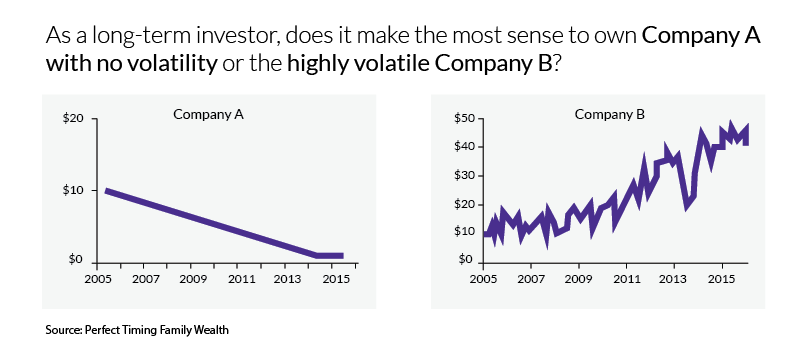Almost all assets see fluctuations in their price over time. But while price swings are a common phenomenon in most asset classes, they have become most famous within the stock market. This fluctuation in price is most commonly referred to as “volatility”. It can be observed in the price of individual stocks right up to broader markets such as the S&P 500 of TSX indices.
Volatility is a measure of the frequency and severity of price movement in a given market. It is a historically ever-present force in the stock market but contrary to popular belief, it is far from the only factor to consider when evaluating investment risk. In fact, as we will discuss, it is one of the largest contributors to an investor’s long-term investment growth.
Put simply, volatility measures how a stock trades and not necessarily how much business risk it holds.
Consider the following example. Company A isn’t volatile but provides a false sense of security as over time, it’s stock price has steadily declined to near zero. On the other hand, Company B – while chock full of short-term price fluctuation – is trending higher in the long run.

So, what’s at the root of these up and down price movements anyway? Volatility can be a sign of market investors acting emotionally rather than rationally. History proves that in the short term, stock markets don’t operate so much on mathematical principles as they do on behavioural psychology. The tech bubble is an obvious example of emotions overtaking investors’ common sense. More recently, escalated foreign trade tensions and geopolitics have caused a tremendous amount of uncertainty and sent volatility soaring once again.
Short term volatility, like that seen in 2019, is far from a cause for concern. In fact, good money managers watch for this kind of volatility as it presents a buying opportunity to move into new positions that previously may have been over valued or less attractive. In fact, volatility is the only way patient investors can yield above average returns over appropriate time horizons.
It can be a vicious circle. Investors react to short-term “noise” based on market speculation in news headlines or opinionated industry pundits, and buy or sell stocks on emotion. Investors then react to those market movements, creating –you guessed it. Far too often the greatest risk investors face isn’t from external forces but rather their own harmful behaviour.
In summary, volatility shouldn’t be viewed as risk. It may feel like it but in reality, it doesn’t represent risk in the true sense. True risk is the opportunity for a permanent loss of capital.






